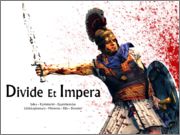Quinquereme - Classiarii
A quinquereme is a 45 meter long galley with three decks of oars, in a pattern of 2-2-1 oarsmen, developed around 400 BCE by the Syracusans. Its large size allows many marines on board, and also allows ballistae to be mounted on the large decks.(Roman Marines)
The 'five', called a quinquereme in Latin and a penteres in Greek, was a ship first used by the Syracusans against the Carthaginians sometime around 398BC. Like other polyremes, a term meaning many-oared, the chances were that it did not have five banks of oars but that the word 'oar' was used to mean 'rower'. In such a case, the arrangement of rowers would be two-two-one going up from the waterline. It makes sense to keep as much weight as possible low in the vessel to help its stability; a high centre of gravity makes any ship liable to capsize if struck from the side. The quinquereme, then, would be a formidable vessel both in terms of appearance and combat value. With a large fighting contingent aboard and plenty of deck space, this heavy vessel could cope with most enemies and threats.
(Classiarii)
During the 4th century BC the Romans abandoned the phalanx in favour of armies consisting chiefly of hastati, principes and triarii. These were deployed in maniples: compact blocks of men, arranged in a checkerboard formation. This allowed flexibility when moving across the battlefield, particularly when compared to the sluggish movements of a solid pike phalanx. Like most sophisticated city-states of the ancient world, Rome expected its men to fight, and supply their own war gear when they did so. A cynical observer might be tempted to note that the manipular Legion also made sure that the hierarchy of Rome was preserved. The youngest and least wealthy became hastati, the first line of battle in a Roman Legion. Behind them came the second line of principes, older and richer men, and finally came the triarii, the most experienced warriors. “Going to the triarii” was a Roman saying that came to be used in all kinds of situations, implying that everything else had been tried and found wanting.
Unit Name Quinquereme - Classiarii |
Main Unit Key Rom_Assault_Quinquereme_Admiral |
Land Unit Key Rom_Marines |
Naval Unit Key roman_five |
Soldiers 140 |
Category Medium Ship |
Class Melee Ship |
Custom Battle Cost 1438 |
Recruitment Cost 1438 |
Upkeep Cost 360 |
Missile Damage 15 |
├ Missile Weapon pilum1 |
├ Projectile pilum1 |
├ Missile Damage 12 |
├ Missile Ap Damage 3 |
└ Base Reload Time 6 |
Accuracy 5 |
Range 80 |
Reload 0 |
Shots Per Minute 10 |
Ammunition 4 |
Ship Health 1020 |
└ Ship roman_five |
Ship Speed 3 |
Melee Attack 24 |
Weapon Damage 10 |
├ Melee Weapon gsword3 |
├ Weapon Damage 10 |
├ Weapon Deadliness 0 |
├ Armour Piercing No |
├ Bonus vs. Cavalry 0 |
├ Bonus vs. Elephants 0 |
└ Bonus vs Infantry 0 |
Charge Bonus 13 |
Melee Defence 79 |
├ Base Defence 21 |
├ Shield shield6 |
└ Shield Defence 58 |
Armour 14 |
├ Armour arm8 |
├ Armour Defence 14 |
└ Shield Armour 0 |
Health 22 |
├ Man Entity medium_medium |
├ Man Health 20 |
└ Bonus Hit Points 2 |
Base Morale 65 |
Abilities
Quinquereme- Row Hard 20
Increases speed for 20 strokes.
Ship speed
- Stamina (low)
Governs how fast the unit tires and restores fatigue, and is dependent on type of unit, weight and approach to combat.
Attributes
- Disciplined
This unit does not suffer a morale penalty when the general dies. It can also rally after routing more often. - Hide (forest)
This unit can hide in forests until enemy units get too close.
Strengths & Weaknesses
Quinquereme- Good hull strength
- Medium crew
- Average speed
- Average ramming
- Poor boarding
- Good missile combat
- Good attack
- Average defence
- Average damage but low armour penetration
- Normal morale
| Faction Availability | |
|---|---|
| Grand Campaign | |
| Samnite Wars | |
| Hannibal at the Gates | |
| Macedonian Wars | |
| Total War: Rome II |
|---|
 Divide et Impera > 
|
| Factions |
| Units |
| Auxiliary Defense Legion |
| Auxiliary Map New!! |
| Custom Battle Units |
| Buildings |
| Technologies |
| Household |
| Skills & Traditions |
| Army New!! |
| Regions |
| Mercenaries |
| Mercenaries Map New!! |
| Character Traits New!! |
| Compare Units New!! |
Factions
Units
Units in Custom Battle
Buildings
Technologies
Household
Regions
Mercenaries
Total War: Rome II
Factions
Units
Auxiliary Corps
Units in Custom Battle
Buildings
Technologies
Household
Regions
Mercenaries
Total War: Rome II: MODs
Radious Total War Mod
Divide et Impera
Total War: Rome II: ICONs
BullGod's Unit Icons
Normal's Rome II_Units Icons
Factions
Units
Shogun 2: Rise of the Samurai
Shogun 2: Fall of the Samurai
Napoleon: Total War
Factions
Units
Empire: Total War
Factions
Units
Factions
Units
Army
Buildings
Mercenaries
Retinue
Traits
Regions
Ranking
Medieval II: Total War: Kingdoms
Medieval II - Americas
Medieval II - Britannia
Medieval II - Crusades
Medieval II - Tutonic
Broken Crescent 1.05
Broken Crescent 2.02
Stainless Steel 5.1b
Stainless Steel 6.1
Deus Lo Vult 5.7
Deus Lo Vult 6.0
HTF: Eagle of the Elbe 05
The Long Road 2.0
Lands to Conquer Gold
DarthMod 1.4D: The Last Episode
Das Heilige Romische Reich 06
Third Age 1.3
Third Age 1.4
Third Age 2.1
Third Age 3.1


 Français
Français Italiano
Italiano Deutsch
Deutsch Español
Español Русский
Русский Čeština
Čeština Polski
Polski Türkçe
Türkçe 简体中文
简体中文 正體中文
正體中文 日本語
日本語